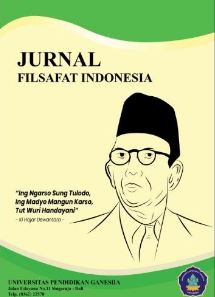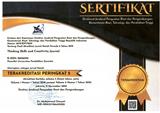Perkembangan Metode Klasifikasi Citra Penginderaan Jauh dalam Perspektif Revolusi Ilmiah Thomas Kuhn
DOI:
https://doi.org/10.23887/jfi.v6i3.53865Keywords:
image classification, remote sensing, scientific revolution, Thomas KuhnAbstract
The rapid improvement of remote sensing technology has given rise to three paradigms of remote sensing image classification methods, namely pixel-based, object-based, and scene-based. This article aims to explain or reveal the development of remote sensing image classification methods and their relationship with Thomas Kuhn's scientific revolution process (pre-paradigm, normal science, anomaly, crisis, and scientific revolution) that occurs in the development of these classification methods. The preparation of this article uses a descriptive qualitative method. Reference sources are journal articles collected from the Scopus database with topics related to classification and remote sensing. Other reference sources are data extracted from review articles. From all the references collected, a literature study is then carried out by analyzing the article's title, abstract, and overall content. After that, the stages of the scientific revolution related to the development of classification methods in remote sensing images were described. Based on the review of the articles, it can be explained that the development of classification methods for remote sensing imagery began in the 1970s when the Landsat satellite was first launched. In this early period, the classification method used was based on pixels or sub-pixels, because the spatial resolution of remote sensing imagery was shallow. As remote sensing technology developed, in the 2000s a new approach was discovered that was more efficient than the pixel-based approach for classifying high-resolution imagery, namely object-based classification methods. Then, with the release of the land use dataset (UC-Merced) in the 2010s, scene-based remote sensing image interpretation began to be used, as pixel- and object-based methods were insufficient to classify correctly.
References
Baatz, M. (2000). Multiresolution segmentation: An optimization approach for high quality multiscale image segmentation. Angewandte geographische informationsverarbeitung, 12–23.
Berg, P., Pham, M.-T., & Courty, N. (2022). Self-Supervised Learning for Scene Classification in Remote Sensing: Current State of the Art and Perspectives. Remote Sensing, 14(16), 3995. https://doi.org/10.3390/rs14163995
Blaschke, T. (2010). Object Based Image Analysis for Remote Sensing. ISPRS journal of photogrammetry and remote sensing, 65(1), 2–16.
Blaschke, T., & Strobl, J. (2001). What’s Wrong With Pixels? Some Recent Developments Interfacing Remote Sensing and GIS. 12–17.
Campbell, J. B., & Wynne, R. H. (2011). Introduction to Remote Sensing. Guilford Press.
Cheng, G., Han, J., & Lu, X. (2017). Remote Sensing Image Scene Classification: Benchmark and State of the Art. Proceedings of the IEEE, 105(10), 1865–1883. https://doi.org/10.1109/JPROC.2017.2675998
Cheng, G., Xie, X., Han, J., Guo, L., & Xia, G.-S. (2020). Remote Sensing Image Scene Classification Meets Deep Learning: Challenges, Methods, Benchmarks, and Opportunities. IEEE Journal of Selected Topics in Applied Earth Observations and Remote Sensing, 13, 3735–3756. https://doi.org/10.1109/JSTARS.2020.3005403
Feyerabend, P. (2020). Against method: Outline of an Anarchistic Theory of Knowledge. Verso Books.
Fisher, P. F., & Pathirana, S. (1990). The Evaluation of Fuzzy Membership of Land Cover Classes In the Suburban Zone. Remote Sensing of Environment, 34(2), 121–132. https://doi.org/10.1016/0034-4257(90)90103-S
France, M. J., & Hedges, P. D. (1986). A Hydrological Comparison of Landsat TM, Landsat MSS And Black & White Aerial Photography. Remote Sensing for Ressources Development and Environmental Management. International symposium. 7, 717–720.
Haack, B. N. (1982). Landsat: A Tool for Development. World Development, 10(10), 899–909.
Herold, M., Gardner, M. E., & Roberts, D. A. (2003). Spectral Resolution Requirements for Mapping Urban Areas. IEEE Transactions on Geoscience and remote sensing, 41(9), 1907–1919.
Jensen, J. R. (2015). Introductory Digital Image Processing: A Remote Sensing Perspective (4th ed.). Pearson.
Kesuma, U., & Hidayat, A. W. (2020). Pemikiran Thomas S. Kuhn Teori Revolusi Paradigma. Islamadina : Jurnal Pemikiran Islam, 166. https://doi.org/10.30595/islamadina.v0i0.6043
Kirchhof, W., Haberäcker, P., Krauth, E., Kritikos, G., & Winter, R. (1980). Evaluation of LANDSAT Image Data for Land-Use Mapping. Acta Astronautica, 7(2), 243–253. https://doi.org/10.1016/0094-5765(80)90064-8
Kuhn, T. S. (1970). The Structure of Scientific Revolutions ([2d ed., enl). University of Chicago Press.
Lakatos, I. (1970). Falsification and the Methodology of Scientific Research Programmes. Dalam A. Musgrave & I. Lakatos (Ed.), Criticism and the Growth of Knowledge: Proceedings of the International Colloquium in the Philosophy of Science, London, 1965 (Vol. 4, hlm. 91–196). Cambridge University Press; Cambridge Core. https://doi.org/10.1017/CBO9781139171434.009
Li, M., Zang, S., Zhang, B., Li, S., & Wu, C. (2014). A Review of Remote Sensing Image Classification Techniques: The Role of Spatio-contextual Information. European Journal of Remote Sensing, 47(1), 389–411. https://doi.org/10.5721/EuJRS20144723
Lo, C. P. (1977). Landsat Images As A Tool In Regional Analysis: The example of Chu Chiang (Pearl River) delta in South China. Geoforum, 8(2), 79–87.
Lu, D., & Weng, Q. (2007). A Survey of Image Classification Methods And Techniques for Improving Classification Performance. International Journal of Remote Sensing, 28(5), 823–870. https://doi.org/10.1080/01431160600746456
Mahayana, D. (2022). Filsafat Sains: Dari Newton, Einstein hingga Sains-Data. ITB Press.
Mehmood, M., Shahzad, A., Zafar, B., Shabbir, A., & Ali, N. (2022). Remote Sensing Image Classification: A Comprehensive Review and Applications. Mathematical Problems in Engineering, 2022, 1–24. https://doi.org/10.1155/2022/5880959
Newman, M. E., McLaren, K. P., & Wilson, B. S. (2011). Comparing the Effects of Classification Techniques on Landscape-Level Assessments: Pixel-Based Versus Object-Based Classification. International Journal of Remote Sensing, 32(14), 4055–4073.
Phan, M. H., & Stive, M. J. F. (2022). Managing Mangroves and Coastal Land Cover in the Mekong Delta. Ocean & Coastal Management, 219, 106013. https://doi.org/10.1016/j.ocecoaman.2021.106013
Shivakanth, G., & Tanwar, P. S. (2018). Review On Conventional and Advanced Classification Approaches in Remote Sensing Image Processing. International Journal of Computer Sciences and Engineering, 6(11), 871–879. https://doi.org/10.26438/ijcse/v6i11.871879
Shlien, S., & Smith, A. (1975). A Rapid Method to Generate Spectral Theme Classification of LANDSAT Imagery. Remote Sensing of Environment, 4, 67–77. https://doi.org/10.1016/0034-4257(75)90006-1
Spurr, S. H. (1952). Aerial Photographs in Forest Management. Photogrammetria, 9, 33–41. https://doi.org/10.1016/S0031-8663(52)80004-3
Thompson, M. M., & Mikhail, E. M. (1976). Automation in Photogrammetry: Recent Developments and Applications (1972–1976). Photogrammetria, 32(4), 111–145. https://doi.org/10.1016/0031-8663(76)90008-9
Zhang, T., Yang, X., Hu, S., & Su, F. (2013). Extraction of Coastline in Aquaculture Coast from Multispectral Remote Sensing Images: Object-Based Region Growing Integrating Edge Detection. Remote sensing, 5(9), 4470–4487.
Zhao, Q., Yu, L., Du, Z., Peng, D., Hao, P., Zhang, Y., & Gong, P. (2022). An Overview of the Applications of Earth Observation Satellite Data: Impacts and Future Trends. Remote Sensing, 14(8), 1863. https://doi.org/10.3390/rs14081863
Zhou, W., Troy, A., & Grove, M. (2008). Object-Based Land Cover Classification and Change Analysis In The Baltimore Metropolitan Area Using Multitemporal High Resolution Remote Sensing Data. Sensors, 8(3), 1613–1636.
Downloads
Published
Issue
Section
License
Copyright (c) 2023 Jurnal Filsafat Indonesia

This work is licensed under a Creative Commons Attribution-ShareAlike 4.0 International License.

Jurnal Filsafat Indonesia Undiksha is licensed under a Creative Commons Attribution-ShareAlike 4.0 International License.




